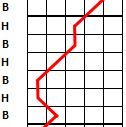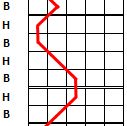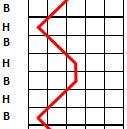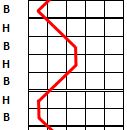
Diagram: 5r.00.05 Stedman - The Line for one bell.
|
The line is characterised by:
- (Treble) hunting out to 4-5
- 2 sixes of double dodging, up & down
- 5 sixes of Slow work
- 2 sixes of double dodging, up & down
- One quick six
The work in the line is sufficiently complicated for a single bell, being a mixture of whole turns and half turns,
wrong way and right way leading and places, and double dodging in 4-5.
A handbell ringer is also looking for the ability to concentrate on one bell and allow the other to be rung "relative" to the first.
However, the complexity of the line in Stedman makes this very hard, especially at the point where one bell is ringing slow work and the other is migrating between dodging positions.
Stedman Doubles is especially hard as there is little time to think between change rows, but the higher numbers bring the difficulty of navigating amongst greater numbers of bells.
The solution to this difficulty has parallels with learning the more complex even bell methods, that is to break the work into small, more memorable sections.
And specifically learning the Slow Work in 5 pieces of six rows that align with the dodging work in 4-5 and above is a key technique.
At this point we introduce a memory technique conceived by Anne and Eddie Martin, which is to associate the work of the individual whole sixes wih a day of the week.
This is documented on the handbell ringing blog at
Conquering Stedman in hand.
|
Monday
Slow 6
|
- 3rds, 3rds;
- 2nds, lead;
- lead, point 2nds.
|

|
|
Tuesday
Quick 6
|
- lead, lead;
- 2nds, 3rds;
- 3rds, 2nds;
|

|
|
Wednesday
Slow 6
|
- point lead at Hand, 2nds;
- 3rds, 3rds;
- 2nds, point lead at Back.
|

|
|
Thursday
Quick 6
|
- 2nds, 3rds;
- 3rds, 2nds;
- lead, lead.
|

|
|
Friday
Slow 6
|
- point 2nds, lead;
- lead, 2nds;
- 3rds, 3rds.
|

|
|
|
The permutations and combinations of various pieces of slow work, for either two bells in the slow, or a quick bell with a slow bell,
or either a quick or a slow bell, with a dodging bell is what makes Stedman a challenging method.
The relevant details are documented for each stage of the method.
|

